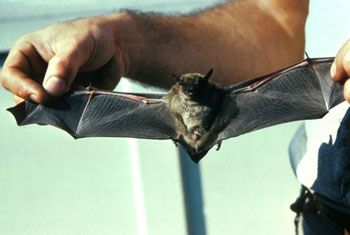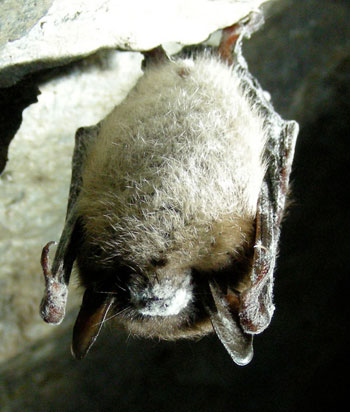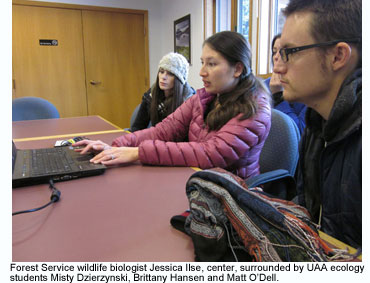If reality TV did college biology, it would look like this
by Kathleen McCoy |
UAA tried out a new biology class this fall, called exploration ecology. Think of it as education outside the box, in real-time. The polar opposite of one professor standing in front of a giant survey class, handing out a dusty syllabus and saying, "Read chapter six and then do the labs."
This class is all about the field trips.
All semester long biology professor Douglas Causey and his 12 students have been tromping
through fields, counting invasive plants, chipping out stream ice to see what's swimming
underneath and hanging recording devices ¬to capture bat echolocation - all in the
Three Rivers area near Girdwood, home to Twenty Mile, Portage and Placer Rivers. Because a class shaped like Causey's places university undergraduates alongside working
state and federal field scientists, it can take a village to deliver. That's possible
by partnering with the Chugach National Forest, a relationship that started in 2011
with the express purpose of using the forest as an extended classroom or "natural
campus." Students and scientists can work together to puzzle out nature's mysteries
on public lands.
Because a class shaped like Causey's places university undergraduates alongside working
state and federal field scientists, it can take a village to deliver. That's possible
by partnering with the Chugach National Forest, a relationship that started in 2011
with the express purpose of using the forest as an extended classroom or "natural
campus." Students and scientists can work together to puzzle out nature's mysteries
on public lands.
So how does that work, exactly? Turn to the bats.
Most Alaskans don't even know we have bats here. Surprisingly, they've been sighted
as far north as Kotzebue, says wildlife biologist David Tessler, with Alaska Department
of Fish and Game.
Since 2002, he's been inviting and collecting citizen sightings to get a handle on
our bats. And about two years ago, he and Jessica Ilse, a wildlife biologist with
the Chugach National Forest, did a tiny pilot project in the Three Rivers area to
see if they could find bats and determine behavior patterns.
"We know next to nothing about Alaska's bats," says Tessler. For a species that you
can't hunt or eat, that's about all the attention bats can expect.
But rather suddenly, understanding bats has become very hot. Since 2006, a fuzzy
white fungus has been threatening little brown bats with extinction across vast swaths
of North America.
From the northeastern United States, south to Alabama, east to Montana and north to
Canada, almost seven million hibernating bats have died from "white nose syndrome."
A pale fuzz that looks like powdered sugar develops on their noses; it wakes them
up repeatedly during hibernation, forcing them to burn extra calories they can't afford.
By the millions, they're keeling over dead. With such a dramatic plummet, federal and state scientists are working to understand
where the fungus came from, how bats get it, why it kills them. Locally, scientists
are trying to figure out if Alaska's bats hibernate locally, or migrate to warmer
climates, which would increase their exposure.
With such a dramatic plummet, federal and state scientists are working to understand
where the fungus came from, how bats get it, why it kills them. Locally, scientists
are trying to figure out if Alaska's bats hibernate locally, or migrate to warmer
climates, which would increase their exposure.
In an ecology class, students learn about nature's interconnectedness. Some U.S. scientists
have calculated that the large loss of bats will leave millions of insects-their dinner-alive
to cause serious trouble for farmers, to the tune of millions of dollars.
Then there's the sad question of whether Alaska might become the last refuge for the
little brown bat.
Three of Causey's students chose to work with Tessler and Ilse on the bat project.
Together they placed recording devices in seven likely locations for bat habitat.
Tessler and Ilse taught them how to use the gear to get good data.
All fall semester, the students organized themselves into a weekly maintenance crew
to retrieve and replace recording cards and renew instrument batteries. Round-trip
for that task? 110 miles.
For bat team member and single mom Brittany Hansen, 26, going to school, working fulltime
as a veterinary tech and mothering a 3-year-old, the extra commitment hasn't been
easy. But she considers the chance to work on real science valuable enough to go the
extra mile.
"I like being a part of a project that will go beyond me, that has bigger meaning,"
she says. And with future career goals in mind, fieldwork with state and federal scientists
is a magnet. On one weekly trip, the bat team stopped in at the Chugach Forest Glacier Ranger District
office to share their data with Ilse. She taught them how to feed it into a software
program that displays ultrasonic recordings as dots on a lined spectrum, almost like
musical notes on a scale. The students didn't know yet if they'd succeeded in recording
any critters.
On one weekly trip, the bat team stopped in at the Chugach Forest Glacier Ranger District
office to share their data with Ilse. She taught them how to feed it into a software
program that displays ultrasonic recordings as dots on a lined spectrum, almost like
musical notes on a scale. The students didn't know yet if they'd succeeded in recording
any critters.
It was smiles all around when Ilse proclaimed, "You've got bats!" On her laptop screen,
the "vocals" appear like a vertical Nike swish on a bass clef.
Now students are analyzing their data and getting ready to present findings to the
agency scientists they worked with. Part of their report will be to identify their
next questions.
For Causey, who went on nearly every field trip, this class is an important part of
re-thinking and re-tooling undergraduate science education.
"What they've done, without realizing it," he says, "is learn how the whole process
of science inquiry goes. Their work leads to next questions. And really, that's the
whole point."
-30-
Web Extra:
Alaska Dept. of Fish & Game "Bats in Alaska" page
 "If reality TV did college biology, it would look like this" is licensed under a Creative Commons Attribution-NonCommercial 4.0 International License.
"If reality TV did college biology, it would look like this" is licensed under a Creative Commons Attribution-NonCommercial 4.0 International License.









